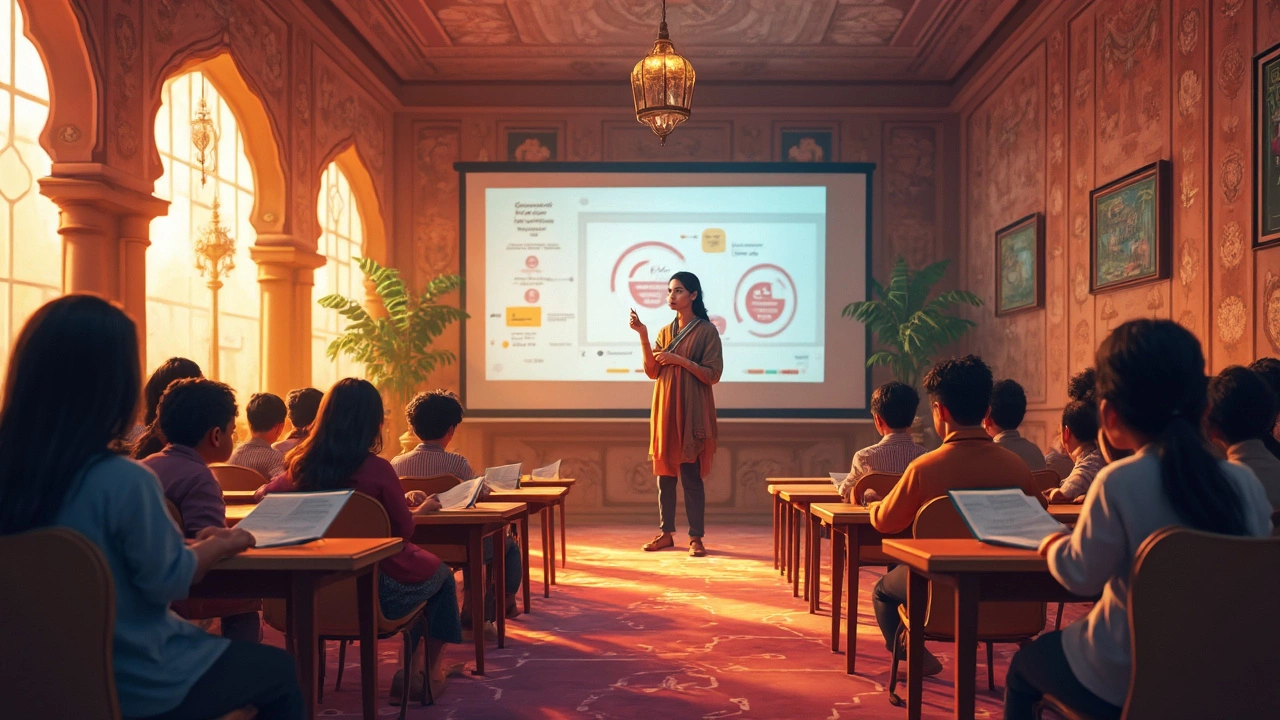So, you're trying to figure out which eLearning model suits you best? You're not alone. With so many options out there, it can be a bit overwhelming. But don't worry, we'll break it down for you. Understanding these models can be super helpful if you're a student, or even if you're an educator planning to teach online.
Let's kick things off with one of the most popular eLearning models: self-paced learning. It's all about flexibility. You get to set your own schedule and learn at a pace that's right for you. Perfect for anyone who has a hectic schedule or just enjoys taking their time to really absorb the material. But remember, self-discipline is key here, because there's no one to push you but yourself!
Self-Paced Learning
Ever felt like life's too fast-paced, and you need to hit pause when learning? That's exactly what self-paced learning offers. It puts you in control, letting you decide when and how much you want to learn. It's like having your favorite podcast on and hitting pause whenever you need a break.
This style of learning never pushes you to keep up with others, which is great if you juggle work, family, or other commitments. You're not tied to a specific schedule, and the materials are available to you 24/7. If something's not clicking, no worries, you can revisit the content as many times as you like.
How It Works
With many platforms offering this model, here's a quick look at how it generally operates:
- You start by signing up for an online course that offers self-paced learning.
- Access the curriculum, often a mix of videos, readings, and quizzes.
- Progress through the materials at your own speed, without deadlines.
- Check your understanding through assignments or tests, often graded automatically.
What's neat? Whether you're brushing up on a skill or diving into something new, you can always fit it around your life, not the other way around.
What’s interesting is a survey in 2023 hammered home how flexible self-paced learning is. Around 67% of users said they prefer this model because it adapts to their ever-changing schedules.
But be warned: self-pacing has its challenges. Procrastination can sneak up on you if you're not careful. Staying disciplined is key. Set goals, stick to a routine, and maybe even buddy up with a friend to keep yourself accountable.
Best Practices
Want to ace this learning style? Here are some tips:
- Plan your week ahead and allocate time slots specifically for learning.
- Set short-term goals that build up to larger objectives.
- Make a dedicated study space to minimize distractions.
- Regularly review your progress and adjust your schedule if needed.
If you stick with these strategies, you'll see why self-paced learning is such a hit. It’s about making learning fit your life, not fitting your life around learning.
Instructor-Led Online Courses
Instructor-led online courses are like your traditional classroom experience but virtual. You've got a real person, guiding you through the material, just like a classroom teacher would. This style brings in the personal touch and real-time interaction which can make a huge difference when you’re learning something complex.
Why choose an instructor-led online course? Well, if you're the kind of person who thrives on structure and direct feedback, this model might be the way to go. These courses often follow a schedule with specific start and end dates, so you'll need to be ready to commit your time just like you would for live classes.
Some Perks and Challenges
One of the major perks is the interaction. You'll have the chance to ask questions and get answers right on the spot. It's also easier to stay motivated when you know others are learning alongside you, and you're accountable to your instructor.
However, there are challenges too. You’ll need to ensure you’ve got stable internet access and be prepared to stick to the timetable. For some, the lack of face-to-face interaction can be a bit of a hurdle — it's easy to feel less connected to your classmates and teacher.
Typical Structure
Many of these courses incorporate video lectures, live Q&A sessions, and group discussions. Here's a quick idea of what you might expect:
- Live Video Sessions: These are scheduled classes where the instructor delivers the lesson.
- Interactive Discussions: Either in chat or video format, to promote engagement.
- Assignments and Quizzes: Meant to test your understanding and keep you on your toes.
One interesting stat is that over 70% of learners say they feel more engaged when taking instructor-led online courses compared to self-paced ones. So, if engagement is a big deal for you, consider this model.
So, if you're after a structured learning environment with a personal touch, instructor-led online courses could be exactly what you need to balance flexibility with direction.

Blended Learning
Blended learning is like getting the best of both worlds: the perks of traditional in-person learning mixed with the flexibility of online courses. Imagine attending a lecture where you can also access materials and resources online when you're back home. It's a fantastic model for those who enjoy face-to-face interaction but also want the convenience of online learning.
One thing that makes blended learning a standout choice is its ability to personalize education. Teachers can use online tools to track student progress and adapt lessons to fit individual needs. That means if you're breezing through a topic or struggling a bit, educators can adjust accordingly. And let's be honest, personalized teaching can really make a difference.
How Does It Work?
Typically, a blended learning setup mixes in-person classroom activities with online instructional videos, forums, and exercises. Think of it like having your classroom extended onto a digital platform. So, for example, you might attend a physical class once a week, while the rest of the course happens online.
- Face-to-Face Instruction: Traditional class meetings for group activities, discussions, and hands-on projects.
- Online Components: Video lectures, quizzes, and forums to enrich learning outside of class.
The beauty of this model? It allows more interaction and engagement versus purely online or in-person approaches. Plus, it fosters a community spirit, both online and offline. And you know what's amazing? Blended learning can often lead to higher retention rates because you get all the benefits of multiple learning styles.
The Impact and Stats
Around 73% of educators believe blended learning increases student engagement (pretty convincing, right?). Students, on their part, report being more satisfied since they get to balance their own pace with face-to-face support.
| Aspect | Benefit |
|---|---|
| Flexibility | Learn at own pace |
| Engagement | Higher interaction levels |
| Adaptability | Personalized learning paths |
All in all, blended learning aims to provide a robust and interactive learning environment by cleverly combining different teaching methods. If you like the idea of variety, this might be the eLearning model for you!
Flipped Classroom
The Flipped Classroom model turns traditional learning on its head. Instead of introducing new concepts in class and sending students home with practice exercises, this model does the opposite. You'd watch lectures or read materials at home, and class time is reserved for problem-solving and discussions.
Why It's Effective
This approach is great for students who like to engage more actively rather than passively listening to a lecture. It encourages participation and lets students dive deeper into topics during classroom sessions. It's also excellent for teachers as it allows them to interact more with students individually, addressing specific questions and fostering discussion.
How It Works
Typically, instructors provide pre-recorded lectures or assign readings that students go through before class. During the live sessions, the focus shifts to applying that knowledge through discussions, group work, or hands-on activities.
The result? Students often report better understanding and retention of material, thanks to the active learning environment. In fact, a study from 2023 found that students in flipped classrooms outperform their peers in traditional setups by about 10% on exams.
Getting Started
- Instructors should prep engaging materials for students to study on their own. Videos, slides, and articles usually work well.
- Plan interactive, engaging in-class activities. Think discussions, group projects, or case studies.
- Incorporate technology—like discussion boards or online quizzes—to keep track of how students are doing and what topics they struggle with.
If you love collaborating and tackling problems with others, the flipped classroom might be just the eLearning model you're looking for!

Massive Open Online Courses (MOOCs)
Ever stumbled across a course online and wondered who could possibly teach so many people at once? Enter MOOCs. These courses are designed to accommodate huge numbers, and they're a big hit in the online learning world. Think of platforms like Coursera, edX, and Udacity. They're pretty revolutionary in terms of scale.
What's cool about MOOCs is that they're often free or very low cost. They've democratized access to education, breaking down traditional barriers. Now, anyone with an internet connection can learn from top universities like Harvard or MIT. Sounds unreal, right?
Why MOOCs are Popular
There are tons of reasons why MOOCs have taken off. First, there's the flexibility. You can learn from anywhere in the world, and oftentimes at your own pace. Plus, the variety is incredible. You can find courses on almost any topic imaginable.
Another major draw is the community aspect. You get to interact with thousands of peers from different backgrounds. You'd be surprised at how much you can learn from discussions and shared perspectives—even through your screen!
Challenges MOOCs Face
Not everything about MOOCs is rainbows and butterflies, though. Completion rates are one of the biggest challenges. Many start with enthusiasm but drop off along the way. It's easy to do when there's no one keeping tabs on you.
Then, there's the question of quality. With so many users, maintaining a high-quality experience for everyone can be tough. But many platforms are innovating with AI and smart analytics to tackle these issues.
| Platform | Courses Offered | Languages Available |
|---|---|---|
| Coursera | 7,000+ | Multiple |
| edX | 3,000+ | English, Spanish, French |
| Udacity | 200+ | English |
Bottom line? Whether you're a newbie or a seasoned learner, MOOCs offer a flexible, accessible way to deepen your knowledge. It's an exciting time to learn, and MOOCs are at the front of this movement.
